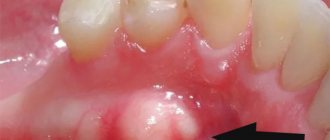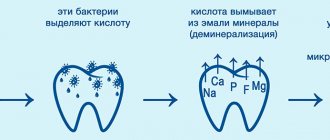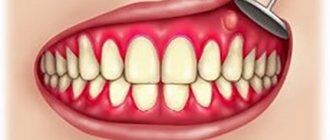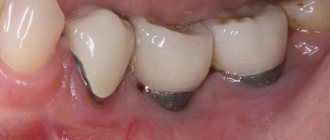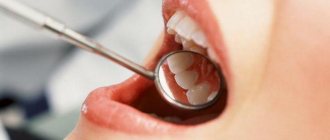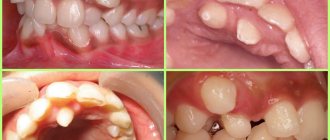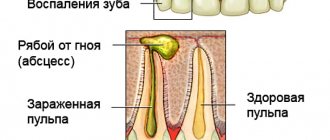- What is a gum former: photo
- What happens after a healing abutment is installed?
- Why does my gum hurt after inserting a gum former?
- The gum former fell out: what to do
- How long to wear
- Gum former: how long does it take to heal?
- How to place a gum former
- Possible complications
- Is it possible to do without a gum former?
- What manufacturers are there?
Dental implantation is one of the most modern and effective methods of orthopedic dentistry. It allows you to restore the integrity of the dentition, correct aesthetic defects and restore the functionality of the dental system. The essence of the procedure is to perform an operation with the installation of an implant, onto which a prosthesis is subsequently attached. Some patients still believe that implantation is an expensive service that is not available to many people. Nowadays it is possible to purchase all consumables at an affordable price; everyone can restore long-missing teeth and restore an attractive appearance to their smile.
Patients have many questions regarding the specifics of implantation, what stages it consists of, etc. An artificial tooth consists of several important elements; in addition to the titanium root, other products are involved in its formation. For example, a gum former device, little is known about it, but without it it is impossible to perform an operation. Today we decided to answer the most common questions about this product, why it is needed at all, what it looks like and what it consists of.
The absence of one or more teeth is a problem that every person can face. The patient almost immediately contacts the dentist for help when a defect occurs on the front part of the dentition, because he is noticeable to others, and he will no longer be able to simply smile. In the event that a molar is lost, which may not be visible, then treatment is postponed until later. Delay is fraught with serious consequences, which makes it difficult to carry out high-quality prosthetics.
The specialists of the A-medic clinic are often asked the following questions regarding the installation and care of the gum former. We answer the most popular and useful of them.
What is a gum former: photo
Many sites that describe the step-by-step process of implantation often do not mention this element, because it is often confused with an abutment, which is a serious mistake. You can look at what a gum former looks like on the Internet or ask your doctor to show it to you. The procedure does not take much time; after the implant is implanted, this structure is installed on it. Then the doctor sutures the wounds, but the former must remain on top of the gingival contour. It is made from special metals, usually titanium, which makes it hypoallergenic and has a low risk of rejection. Titanium alloy is corrosion-resistant and lightweight, it does not load the implant. Its size directly depends on the type of tooth being restored. The main purpose of this device is the formation of soft tissue around the titanium root, so that later the connection between the prosthesis and the gums looks natural and aesthetically pleasing. After its use, it acquires the desired density and volume.
What it is?
The gum former is a one-piece structure that is screwed into the artificial tooth root immediately after implantation or 3-6 months later.
What does it look like
Externally, the gum former resembles a thick metal screw with a tight thread and a cylindrical upper part according to the size of the future tooth. Thus, its appearance follows the contours of the teeth and roots in their natural form.
The multi-turn thread of the former allows you to securely fasten the entire metal structure in the artificial tooth root. The shape and size of the former depend on which tooth is being restored and are individual in each specific case.
The purpose of installing a former is to create the correct contour of the gum (socket) around the tooth. The further appearance of the area with the implant and how tightly the gums will adhere to the prosthesis depend on its use.
The former allows the gum located within the artificial root to take on the desired fullness and volume that is necessary to create a natural contour.
Photo: what a gum former looks like
Material
Titanium is becoming a traditional material for the production of shapers. Its strength characteristics are complemented by amazing lightness, so installation of the former does not create unnecessary stress on the root of the tooth being restored. In addition, titanium has increased corrosion resistance, which is important when installed in the oral cavity.
However, titanium formers have one significant drawback that limits their use. They tend to show through the gums, which is not very aesthetically pleasing for the front teeth. In this regard, many patients prefer to install zirconium structures instead of titanium ones, the color of which does not stand out against the background of soft tissues.
Abutment and healing abutment: the same thing or not?
In addition to formers, so-called abutments are used in implantation practice. But they should not be confused. The abutment is a more complex structure and is installed after the formation of the gums into the same implant instead of the former. Its function is to create additional strength for the prosthesis placed on it.
Unlike the former, whose top is made in the form of a cylinder, the shape of the abutment can be different and is selected for a specific prosthesis. Depending on the purpose, abutments can be temporary, standard, angled, cast (connected to the implant) and individual. For abutments, materials such as ceramics, titanium, gold, plastic and their combinations are used.
Classification
Of the materials for dental implantation presented on the modern market, several classes of formers stand out:
- economy : Adin, Alpha Bio, MIS, Iterum (Israel), Bicon (USA), Implantium (Korea, USA);
- business : Xive (Germany);
- premium : Straumann (Switzerland), Astra tech (Sweden), Nico, Ankylos, Impro, Semandos (Germany), Nobel Biocare (USA).
The formers of some companies may be suitable for implants of other brands, but it is still recommended to use the system of the same name.
What happens after a healing abutment is installed?
In order for artificial teeth to serve you for many years, you need to approach the implantation process with attention to every detail. The specialists of the A-medic clinic follow all stages of the operation; manipulations are carried out under anesthesia, which ensures comfort and painlessness. Dental restoration using the implantation method occurs in stages; after preparing the oral cavity, the doctor proceeds to the main part. Having fixed the implant in the jawbone, the implantologist screws the gum former into the titanium root. Depending on the chosen implantation method, this stage can be carried out immediately after installation of the implant (single-stage technology) or after some time, when the structure has taken root (two-stage method). Thanks to this element, periodontal tissues acquire a natural appearance and fit tightly to the prosthesis. After a tooth falls out, the bone in its place does not receive any load and begins to atrophy and the soft tissues sag, lose their elasticity, and the gums, after the former, restore their original shape.
What happens to the gums during the surgical implantation stage
- Peeling of the mucoperiosteal flap. The area of gum where the implant is installed is cut and shifted to access the bone tissue.
- Preparing the bed for the implant. A narrow channel is drilled, the diameter of which does not exceed 2 mm. The bed is then gradually expanded with wider drills. To achieve maximum accuracy in parameters, a pre-prepared 3D template is used.
- Screwing in the titanium rod. A special tool is used for this. After the part is tightly fixed, it is closed on top with a plug that prevents gum tissue from growing into the internal hole of the implant.
- Stitching. All previously detached areas are returned to their place.
At almost every stage of implant installation, gum injury inevitably occurs.
What it should normally look like during the healing process
The sutured gum looks inflamed for the first few days. Pain, swelling, bleeding, and hematoma may occur within a week. If symptoms do not go away after 5-7 days, you should contact an implantologist.
The duration of osseointegration of the artificial root with the jaw structures varies from two to six months. On the lower jaw it is completed faster than on the upper jaw. Stitches are removed on days 7-10.
At the end of the healing process, the gums look healthy and have a pale pink tint.
Possible complications
Bleeding, swelling, and pain are considered normal in the first days. If symptoms persist or increase, you should urgently visit a doctor.
- Hyperplasia. Rapid tissue growth in the surgical area. The pathology is eliminated by removing part of the mucosa.
- Fistulas, suppuration. The first sign of these unpleasant phenomena is white spots on the gums and plaque. Through them, the purulent contents come out. The inflammatory process can occur due to:
- violations of sterility during surgery;
- unqualified actions of a doctor;
- infectious foci in the vicinity of the operated area;
- injuries to the walls of the nasal sinuses;
- incorrectly selected prosthesis;
- neglect of the rules of oral hygiene.
- inflammatory processes;
- doctor's error;
- trauma to the implant area;
- deficiency of bone tissue volume;
- smoking;
- exacerbation of chronic diseases, emergence of new ones;
- development of an allergic reaction to the pin material.
Strict adherence to the implantation technique by the specialist and adherence to his recommendations by the patient minimize the risk of complications.
First aid for gum disease
At home, if it is not possible to immediately seek dental care, you can use the following recommendations:
- Solcoseryl dental paste will help cope with the symptoms of inflammation. When the product is applied to the operated area, pain is reduced and gum tissue is regenerated.
- Follow a diet. Spicy, hard, hot and cold foods fall into the restricted area. Food should have a liquid consistency to prevent chewing. Ideally, the food temperature should be as close as possible to body temperature.
You need to sleep on a high pillow so that your head is located higher relative to the level of your feet. This will ensure blood flow away from the inflamed area, which will reduce swelling.
Treatment of complications
Implantation is a complex procedure, and patients are often prescribed antibiotic therapy immediately after surgery. It is aimed at preventing the development of infectious processes. In addition, antiseptic wound-healing drugs are used.
Chlorhexidine 0.05%. An antiseptic with disinfecting properties is used for oral baths in the first days after installation of implants. The liquid is held on the side of the installed implant for 2-3 minutes and then spat out. Use the solution 4 times a day. For one bath, 15 ml of product is enough. 5 days after implantation, when the wound has healed, more active rinses can be used.
Betadine 10 % To relieve inflammation, dilute 3 drops of antiseptic liquid in 100 g of water. Oral baths are taken 4-6 times a day. The product stops the development of the infectious process, creates a protective shell, and restores damaged tissue.
Amoxiclav . The drug contains amoxicillin and clavulanic acid. Together, the substances inhibit bacteria and prevent their enzymatic action. Inflammation is relieved and healing of the gum surface damaged during implantation is accelerated.
Dexalgin . Anti-inflammatory non-steroidal drug with analgesic effect. The action lasts from 3 to 6 hours. The drug reduces swelling, normalizes temperature, and relieves pain.
Why does my gum hurt after inserting a gum former?
Very often, patients come to the clinic after surgery with a complaint of pain. Should I panic in this case and immediately call a doctor? To answer this question, you need to determine the cause of your anxiety. Before starting the operation, the doctor gives the patient an injection with an anesthetic, so the patient does not feel pain during the entire process. When the anesthesia wears off, pain may occur and continue for several days after implantation. This is quite normal, while the soft tissues are healing and your body is adapting, you may be bothered by this symptom. If the pain does not go away within a week and only intensifies, causing you discomfort, then you should urgently seek help from a doctor. Monitor your condition carefully; some changes may indicate the development of complications. Based on this, we can conclude that if your gums hurt after installing a gum former, then you should not immediately sound the alarm, assess your condition and how long the pain lasts. If complaints arise immediately after the end of anesthesia, then you should wait a few days. The discomfort will either pass or begin to bother you with renewed vigor, in which case you should contact your doctor.
Installation procedure
The process of prosthetics using the classical technique takes about 3 months. There are situations when dental restoration stretches over long periods of time.
The procedure itself in dentistry is called microsurgery. Often everything goes smoothly without any difficulties. The manipulations are practically no different from dental treatment or standard resection.
The structure is fixed under local anesthesia. The process of fixing the product takes 30-40 minutes. Installation of the gum former on the implant is carried out in several stages:
- Access to the fixation system (platform) through a soft tissue incision. The orthopedist determines the location of the prosthesis by palpating certain areas or using a special probe. A surgical incision is then made above the platform. The location of the incision may vary if the dentist plans to move the keratinized epithelium. If the denture is deep, the orthodontist removes a layer of tissue and removes weakening reserves.
- The second stage involves preparing the prosthesis for fastening the former. To do this, a plug is removed from the implant shaft to cover the end hole. The surface of the product is thoroughly cleaned, removing excess soft tissue.
- Then the former is fixed. After preparing the metal root, the orthopedist removes the forming part from the special packaging and screws it in. Manipulations can be carried out either manually or using a special key-tip. If the product is chosen correctly, it should rise slightly above the gum.
- At the next stage, stitches are placed to speed up healing. The gum is sutured by applying classic sutures until an interdental papilla appears, which acts as a biobarrier and also creates an aesthetic appearance.
The gum former fell out: what to do
It is also possible that the former becomes unscrewed and falls out of the implant. This may occur due to a loose fit of the element to the titanium root. This happens when the surgeon secured the implant too deep into the bone, and bone tissue grew on it, making it impossible to secure the former tightly. To correct this deficiency, you need to visit a doctor. When the gum former has already fallen out, the first thing you should do is carefully screw it into place and make an appointment with the dentist. Without a plug for a long time, the hole may become overgrown.
Why does the complication occur?
Complications after implantation do not occur often. Before the procedure, there is a long preparation process, during which the risk of unpleasant consequences is reduced. But no one is immune from this. You need to know what to do when an implant protrudes from the gum and why this happens.
With two-stage implantation, it is assumed that the implant will be hidden, that is, completely covered by the gum. This does not happen immediately, but within 3 and 6 months for the lower and upper jaw.
The reasons for this complication are:
- errors in the process of flap formation, excessive tension;
- non-compliance with the rules of postoperative wound care;
- excess pressure of the temporary prosthetic structure.
The problem may also arise when the implant is rejected, but it does not always come out. If this is the reason, in addition to the visibility of the metal element, symptoms of the inflammatory process will be present.
Complications may be caused by implantologist errors. The first is the wrong choice of metal structure. In this case, it will be poorly fixed and rejection or exposure will occur. The problem occurs more often when the bone thickness is insufficient.
The second reason is improper installation of the structure. This may be due to insufficient bone wall thickness and the installation of the pin at an incorrect angle. The third factor is the presence of contraindications to the procedure, which the dentist did not take into account.
Note!
The reason may be the poor quality of the implant. An expensive design from a well-known manufacturer will cause problems in isolated cases.
The risk of rejection and exposure of the structure largely depends on the material of manufacture. The implant must have high biocompatibility with tissues. Preference is given to a porous coating where growing cells can penetrate into it, ensuring strong fusion.
How long to wear
Typically, the process of forming the gingival contour lasts from 2 to 4 weeks; this all happens individually for each person. Therefore, to answer the question: how long can you walk with a gum former? – we can answer that it must be used until the formation of uniform soft tissue edges is completely completed. Your healthcare provider will let you know when to replace the element and secure the abutment. Under no circumstances should you ignore the specialist’s request and continue to wear the gum former.
Installation during pregnancy
Serious hormonal changes occur in the body of the expectant mother. Metabolism is being restructured, because Fetal nutrition is carried out at the expense of the resources of the mother's body. Against this background, the expectant mother’s immunity decreases, bones and teeth become more fragile. Therefore, dentists do not recommend dental implantation during pregnancy and lactation - so as not to burden the body and not harm the baby with medications.
However, a gum abutment is a more routine procedure. If you are faced with the fact that you had an implant installed before pregnancy and the need to fix the former fell just during this period, it is still worth postponing this stage until after the birth of the baby. After all, both the surgical intervention itself and the local anesthesia that is given during any treatment pose a rather great danger. In addition to the anesthetic, the injection may contain epinephrine (adrenaline), which is contraindicated for pregnant women. In exceptional cases, the installation of a former is allowed only in the second trimester of pregnancy and only with the permission of an obstetrician-gynecologist and dentist. But it is better to postpone this procedure until lactation is completed and the body is completely restored.
Author: Gorovoy E. A. (Thank you for your help in writing the article and the information provided)
Gum former: how long does it take to heal?
When implanting a gum former, how long it takes for periodontal tissue to heal depends on several factors:
- patient compliance with recommendations;
- location of prosthetics, on the upper or lower jaw, type of tooth;
- type of implant.
The formation of the gingival margin is not a quick process; in order to get an excellent result, it is necessary to regularly care for the oral cavity and follow the doctor’s instructions until the process of soft tissue regeneration is completed. If the gum does not heal, and its recovery is accompanied by discomfort and complications, then it is necessary to consult with your doctor. You should not try to eliminate painful symptoms on your own; even mild discomfort may indicate the development of inflammation. Because of this, dental implantation will have to be postponed indefinitely.
Anesthesia
If there is constant pain at the site where the former is installed, you need to do a gentle massage of the gums with tea tree essential oils, which help relieve pain.
A mixture of table salt (fine) and honey relieves pain well. For one part of salt, take 4 parts of liquid honey.
Baths made from infusion of calendula or echinacea flowers are good for pain relief. You should not rinse your mouth, but simply keep the liquid in your mouth and spit. The decoction should be used warm; you should not rinse your mouth with hot liquid - this will cause bleeding. A decoction of echinacea or calendula prevents the development of inflammatory processes.
How to place a gum former
There are several options for implantation; when it is necessary to immediately restore a newly extracted tooth, it is more advisable to use a one-stage technique; if there is no urgency, then the doctor can suggest a classical technology - a two-stage one. Let's take a closer look at how the gum former is installed in these two methods.
During two-stage implantation, the specialist performs the following actions:
- He administers anesthesia, dissects the gums, and uses a special tool to form a bed for the implant.
- He then inserts a titanium screw into the bone, attaches a plug to it, and sutures the wound.
- After the surgical stage, a period of 3-6 months begins, during which the process of osseointegration takes place. That is, during this time the implant must fuse with the bone and be securely fixed in it.
- After the orthopedic system has successfully taken root, the doctor proceeds to the next stage. The gum is cut and the former is screwed into the implant.
- After a few weeks, this element is removed and an abutment is installed in its place, after which a prosthesis, previously made according to individual casts of the patient’s jaw, is fixed onto it.
When carrying out one-stage implantation, the process of tooth restoration goes much faster, this is the main difference between these two methods from each other. The algorithm of actions is as follows:
- The implantologist cuts the gum, forms a bed and installs the implant together without a former. To prevent the defect from being noticeable, the patient is given a temporary crown; after a few months it will be replaced with a permanent one. In this case, the gums grow naturally around the prosthesis, thereby restoring the aesthetics of the dentition.
Many specialists insist on the use of a gum former, especially in cases where the patient experiences subsidence or loss of periodontal tissue.
Installation
What is a healing abutment? This is a pin made of a hypoallergenic metal alloy (zirconium, titanium) in the form of a screw with a cylindrical head. Special metal alloys do not interact chemically with salivary fluid and do not cause irritation to surrounding tissues. Ceramics and plastic are rarely used to make a pin.
Inside the titanium (zirconium) pin, the orthopedist inserts a screw with a head of the required size - larger/smaller. After some time, a hole and a gingival cuff are formed in place of the pin. The gum tissue tightly grips the metal pin, and now a permanent implant can be implanted.
The cylindrical head of the screw is the size of a future dental crown, so the implantation of an artificial implant will go smoothly.
Pin installation steps:
- implantation of a metal root into the bone tissue;
- introduction of the former after engraftment of the artificial root;
- installation of a permanent abutment instead of a temporary one and fastening of a crown.
The entire procedure for forming a gingival cuff takes several months, sometimes more than six months. This is due to the condition of the tissues of the mucous membrane and jaw bones. The former itself can be introduced six months after the installation of the artificial root.
There is also a one-stage installation of a temporary abutment, but it is only suitable for young people with strong gum tissue and healthy bone tissue.
Possible complications
Periodontal tissues do not always heal successfully and quickly around the gum former; complications are possible and no one is immune from them. The doctor’s experience, compliance with sterile conditions during implantation and proper care will reduce the risk of unpleasant consequences after the installation of this element.
After surgery, the patient may experience the following complications:
- Edema. Very often, patients are bothered by this symptom, in which case the doctor should reassure you and explain that the swelling will subside in a few days. This is a normal phenomenon, this is how our body reacts to surgery. However, it is worth paying attention to this problem if the swelling after installing the gum former does not go away within a week. This may be due to the fact that the design compresses soft tissues, then it needs to be replaced with another one.
- Bleeding. This sign is also not alarming; usually bleeding after the installation of a gum former appears in people with a low level of blood clotting. The doctor should warn the patient about the possible consequences and, if necessary, prescribe healing medications.
- Pain. If you are bothered by unpleasant and even painful sensations in the neck and throat for a long time after surgery, then you should pay attention to the quality of hygiene. Lack of thorough and regular oral care and an established system can cause the development of this complication. But remember that in the first 2-3 days after surgery, pain at the site where the former is screwed in is normal. If the pain does not disappear, you should seek help from a doctor.
- Allergy. It is also possible that a patient develops an allergic reaction to the material used in prosthetics or to anesthetic drugs. This may happen due to a specialist, because... At the stage of preparation for implantation, he is obliged to find out if the patient has an allergy; in case of an unclear situation, a special test is carried out.
We have listed the main complications that may arise in the postoperative period. As we see, some of them are a consequence of surgical intervention and go away on their own within a few days. But do not forget to monitor your condition and follow the rules of care; when alarming symptoms have been bothering you for more than 5-6 days, you need to urgently consult a doctor.
Average cost in Moscow
Here are the approximate prices in metropolitan clinics for implantation and other dental services related to it.
| Name of service | Cost, rub. |
| Turnkey implantation | |
| Classical implantation with installation of a metal-ceramic crown | 39100 |
| Classical implantation with installation of an all-ceramic crown | 50200 |
| Removable prosthesis on implants with ball-shaped fastening | 54700 |
| Express implantation with installation of a metal-ceramic crown | 58000 |
| Classical implantation with installation of a ceramic crown on a special alloy | 60000 |
| Removable denture on implants with beam fastening | 160000 |
| Installation and removal of implants | |
| Installation of the healing abutment | 3700 |
| Implant removal | 6900 |
| Implantation of osteoconductive material in the area of 1 tooth | 9600 |
| Installation of a mini implant | 11700 |
| Implantation of a protective membrane of 1 tooth | 12700 |
| Installation of a temporary implant | 14700 |
| Express implantation (in one stage) of 1 tooth | 33900 |
| Classic implantation of 1 tooth | 44800 |
Cost of medications to relieve inflammation and pain at home
| Medication | Cost, rub. |
| Chlorhexidine 0.05% | 60 |
| Betadine 10% | 270 |
| Solcoseryl | 300 |
| Amoxiclav | 330 |
| Dexalgin | 400 |
Is it possible to do without a gum former?
Why is a gum former needed, and is it possible not to use it at all during implantation? This is the question asked by all patients who have been involved in dental restoration. This element is required when carrying out the classical implantation method; it allows you to correctly form the correct gingival contour so that the artificial tooth looks natural and aesthetically pleasing. It can be fixed immediately after implantation or after the process of osseointegration has taken place. When a patient chooses a one-stage implantation technology, usually the stage of installing a gum former is skipped and a crown is immediately attached to the titanium root. But in some cases, when the installation of the prosthesis is delayed for several days, the doctor may install a gum former to preserve the gum contour.
Installation of the former during implantation
During implantation, the gum former is fixed by an orthopedic dentist under conductive anesthesia. After 2–6 months. after the operation, the metal structure is screwed into a special artificial root socket (standard method).
In some situations, the forming element is inserted immediately after the implant is installed (one-step method). The first installation option requires additional surgical procedures, since the implant quickly becomes overgrown with soft tissue.
Methods for installing a gum former during implantation
There are 2 ways to install a gum forming structure:
| Standard | Single-stage |
| This method is characterized by the installation of a former 2–6 months after implantation. Before screwing in the installation, it is necessary to excise the gum. Most often used. | The former is attached immediately after implantation. No additional surgery is required. The method is suitable for patients 22–40 years old with strong periosteum. |
The method of installing the former is selected by the doctor individually. In the case of strong bone tissue and dense gingival zone, it is preferable to choose a one-step method. In the classic version, surgical treatment is extended over several months.
Stages and process of installing the shaper
As is already known, the installation of a gingival element takes several days, and can take place within six months. However, the dental operation itself does not take much time and includes several stages:
- Conducting conduction anesthesia.
- Excision of soft tissue to gain access to the implant socket.
- Removal of mucosal tissue detachments.
- Removing the implant plug screw.
- Screwing the former into the socket using a ratchet wrench.
- Applying sutures to the wound.
What manufacturers are there?
All orthopedic systems can be divided into several classes: premium, business and economy. Gum formers are divided according to the same principle; they are manufactured by the same companies that produce implants. The cost of designs from different brands can vary significantly; usually the doctor tries to select all the necessary components from one company; working with them is much easier and simpler.
Gum former Straumann (Switzerland), Astra Tech (Sweden), Nobel (USA) are premium products.
Products of the Xive brand (Germany) can be classified as business class designs. Gum former osstem (South Korea), Bicon (USA), MIS (Israel) - economy class systems.
When choosing the necessary elements for implantation, the specialists of the A-medic clinic take into account the wishes of the patients and their financial capabilities. We do not impose expensive goods, first of all, thinking about you.
What to do if part of the rod comes out of the gums
When the implant is exposed, a flap operation is performed to build up its soft tissue:
- A flap is peeled off from the palate and applied to the exposed area.
- If necessary, correction is carried out on the bone tissue.
- The edges of the wound are sutured with non-absorbable thread.
- After 10 days, the sutures are removed.
- After the artificial root has engrafted, a former is placed.
Another way to correct a defect with a lack of periodontal tissue can be the transition from a two-stage installation to a one-stage method. However, it is necessary to take into account that the one-stage technique has the main drawback - non-ideal conditions during the period of implant engraftment, high risks of developing inflammation.
Step-by-step installation
The implants immediately have a socket for screwing in the forming element. The procedure is quick and consists of the following steps:
- local anesthesia,
- incision of fused tissue, removal of excess,
- removing the plug covering the hole in the implant,
- screwing in the former,
- suturing.
Local anesthesia will protect the patient from discomfort, but pain may occur after its effect wears off. The doctor will warn you that this is normal. The pain can last a week, it all depends on the characteristics of the body. Increased pain indicates the presence of complications. If this happens, you need to urgently consult a dentist.
When the wound heals, after about 2-3 weeks you can install a crown. The doctor unscrews the forming element and replaces it with a device to make an impression. Your gums may bleed, but this is normal. If it grows unevenly, the impression is put aside, the doctor will have to correct the process, make incisions, and apply sutures.
Stage No. 1 – local, infiltration, or conduction anesthesia is performed, depending on the area in which the implant is located.
Stage No. 2 - dissection of the gums is performed. This is done in order to gain access to the intraosseous part of the implanted base. During the entire period while the implant was in the gum, a certain part of it had already become overgrown with soft tissue. In this connection, to establish the exact localization of the implant, a palpation or probing procedure is performed. The last option is used most often. Subsequently, the soft tissues are opened with a punch or an incision is made above the artificial base.
Stage No. 3 - the base itself is prepared for attaching the former to it. In this case, a special plug is removed, thereby opening the intraosseous part of the thread. The visible metal part is cleaned of excess tissue (if necessary).
Stage No. 4 – at this stage of dental implantation, installation of the gum former involves screwing in the product itself using a special key (orthopedic or universal). It should protrude slightly beyond the gum line, but not more than 2 mm. This indicates that the dimensions were chosen correctly. This measure allows you to avoid correction when using temporary prostheses.
Stage No. 5 – suturing the gums. Moreover, the edges of the soft tissues are pulled together in such a way that the former remains above them, forming something like an interdental papilla.
We suggest you read: The ball doesn’t hurt on the gum - ProfiMed
This work is not only routine, but also responsible - it is necessary to install the products correctly, otherwise unpleasant consequences cannot be avoided. You can check the correctness of fastening of products using orthopantomography.
The duration of the operation to install gum formers takes no more than 60 minutes. After 14 days - by this time the cavity has already healed sufficiently - an elastic cushion forms in the area where the former is installed. This is another way to determine whether the procedure was carried out correctly.
Modern artificial teeth, by default, already have a special socket for installing a gum substitute. Despite the fact that some parts fit together, being products of different manufacturers, experienced craftsmen recommend not to take such risks. Otherwise, the chances of complications increase significantly.
There are two options for introducing the former into the implant:
- one-time;
- standard.
The first version is based on the need to introduce an implant immediately after its implantation. The second variation relies on postponing the second step for several months. During the set time, the structure manages to acquire soft tissues, firmly taking root. But in any case, you will have to come to terms with the fact that pain immediately after the anesthesia wears off is quite normal.
If the victim’s gums hurt beyond the established period for adaptation, then this is a reason to make an unscheduled appointment with a dentist. It is also worth doing if the sore spot reacts to cold, or generally does not behave as promised by the doctor.
This type of surgery falls into the micro-surgery camp. This means that the manipulation does not last particularly long, without affecting large areas to be corrected. Schematically, the entire technique of this type can be divided into several stages:
- anesthesia;
- incision of fused soft tissues to increase the accessibility of fastening;
- removal of excess tissue;
- unscrewing the implant plug;
- screwing in the former;
- suturing.
Moreover, screwing can be done either manually or using a special ratchet-type wrench, depending on the location of the problem area.
Due to local anesthesia, installation does not cause any pain. But swelling or pain after recovery from anesthesia is quite a common occurrence. It is believed that everything should go away over the next few days. If the pain does not go away even after a week, then there is a high probability that you will have to perform a reverse expansion.
If everything with the installation went according to plan, then the crown can be installed after seven days for emergency indications. But usually dentists prefer to wait longer - about three weeks.
Implantation without complications - is it easy?
If you are at the stage of planning dental implantation or are already fully engaged in implantation activities, then you can guarantee the effectiveness of treatment by contacting the Misto Dent clinic. Our clinic has only new, safe equipment installed, thanks to which all diagnostic and treatment procedures are quick and painless.
European quality of dental treatment in Ukraine is “Misto Dent”!
| Call our phone number: 38, we will be happy to answer all your questions or schedule a consultation at a time convenient for you |
Features of oral care
After the former is installed, you should care for your oral cavity in accordance with the following recommendations:
- in the first days of the postoperative period, food can only be taken in pureed form,
- exclude foods and drinks with high and low temperatures,
- for rinsing, use soda solution, decoctions of medicinal herbs,
- in the first days, avoid excessive physical activity, sports training,
- give up cigarettes for at least a day,
- use medications strictly as prescribed,
- Take medications only in consultation with your doctor.
Rinsing with medicinal herbs will help in caring for the oral cavity.
Particular attention is paid to hygienic oral care. The brush should not injure the gums - you need to choose the softest bristles. Rinsing your mouth after eating is mandatory. It is also advisable to use an irrigator.
Installing a former is not a whim of the dentist, but a necessity. Its use guarantees aesthetics and gum health in the future.
Installation cost
The cost of installing the shaper includes the price of the product and the costs of the manipulation itself. Based on cost, structures are divided into 3 classes:
- economy;
- business;
- premium
The most liberal prices are set by manufacturing companies from Israel. Premium and business class shapers are manufactured by companies in America, Switzerland and Germany. When implanting, you can combine designs from different price categories, but experts prefer to use products from the same brand.
Dental implantation has truly become a salvation for people in pursuit of a white-toothed smile. Implants are so identical to natural teeth that patients are increasingly choosing them over dentures and bridges. But remember that artificial teeth also need special care. Remember to brush them daily and visit your dentist regularly.
The video provides answers to all the important questions that arise during the planning period for dental implantation and at the moment when the gums are healing:
Terms of wearing shapers
As a rule, gum tissue heals within 7-10 days from the time of surgery. Under the influence of the anesthetic, the pain is dulled, but after its effect wears off, the pain syndrome returns. There is no need to be afraid of this, as this is the norm. During the first 5-7 days, you can take painkillers.
At the same time, if the pain still remains after a week, you should immediately consult a doctor. With a high degree of probability, this may indicate the development of complications.
Most patients are interested not only in what the gum former looks like, but also how long it should be worn? It is impossible to give exact dates right away, since everything depends on the individual characteristics of the patient. In particular, we are talking about the following:
- The ability of soft tissue and bone structure to heal.
- Localization of the restored zone.
- Type of implant.
- Difficulty of surgery.
- Correctly follow all instructions of the specialist.
If there are no complications, if all the specialist’s recommendations are followed, complete healing occurs within the previously mentioned period - about 2 weeks.
How can you tell if the driver is installed incorrectly?
After installing the gum former, the patient can determine that the doctor made mistakes. It is not difficult to calculate the error; you just need to pay attention to several factors:
- Density of contact between the implant and the former. The former may become unscrewed, become loose, or even fall out if its movement is not noticed in time. Loss of contact often indicates that the screw has been set too deeply into the bone. An incorrectly installed implant becomes overgrown with bone tissue, which prevents the former from being tightly secured. In this case, the doctor must trim the excess bone tissue.
- Shaper location. If the abutment is completely or partially covered by gum tissue, it needs to be replaced.
- Naturalness of sensations. If you feel a foreign object when chewing, then the former needs to be changed to a lower one.
